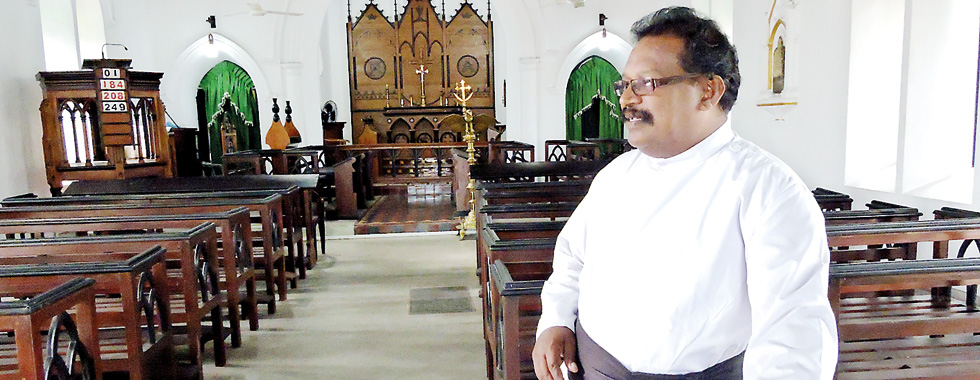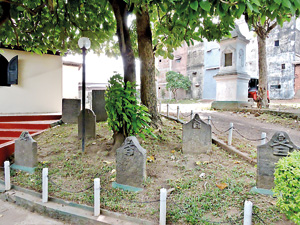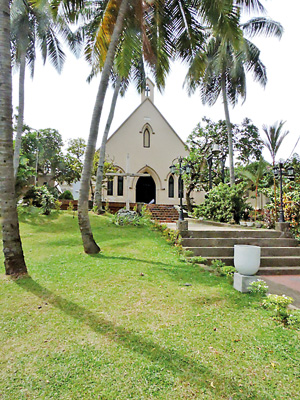200 years at Ginthupitiya
Ginthupitiya for most Colombo-dwellers sounds like a far-off location, possibly a quaint town surrounded by tea plantations in the central hills. In reality, Ginthupitiya is a maze of bustling streets absorbing the spill-over of neighbouring Pettah. Perched on a hillock, overlooking the fast paced life on the streets of Kochchikade and gently-lapping harbour wavelets for the past 200 years is St. Thomas’ Church, Ginthupitiya. These days, its current parishioners have had little time to admire the panoramic view as they were busy preparing to celebrate the 200th anniversary of the church – the thanksgiving service was celebrated by the Anglican Bishop of Colombo yesterday.

The first Anglican Church in the country: Rev. Chandran Crispus recalls its history
St. Thomas Church is the first Anglican church built in Sri Lanka, according to Rev. Chandran Crispus, the current Vicar, who explains that it was reconstructed by British Governor Robert Brownrigg and later consecrated on July 16, 1815. Brownrigg’s name can be seen on the west wall of the church.
History and legend has it that St. Thomas, one of Jesus Christ’s original disciples who is credited with bringing the religion to Asia made a stop at the Colombo port before arriving in India. “He came to preach to the fishermen,” Rev. Crispus says and it is speculated that because of its favourable gradient this place was an ideal location for the Saint to deliver perhaps one of his first foreign sermons. Known as “The Apostle for Asia” it is believed that Thomas lived out his days in the sub-continent and that his remains lie at Mylapore in South India.
When the winds of fate brought Lorenzo De Almeida and his fleet of Portuguese ships to the island, and with them Catholicism, Ginthupitiya was called “San Thome Pitiya” he says citing the works of historian Frederick Medis. The colonisers built a Catholic shrine where St. Thomas’ church sits today. Frederick Medis’s writings on the church as we know it, bring to light that the Portuguese recorded finding a Nestorian Cross in the area indicating the presence of Persian Christians who inhabited the port. “Even before the Portuguese, there have been worshippers in this place,” says the vicar, glancing out at the Colombo harbour from the entrance to his parish.

Still intact: The old gravestones in the church graveyard. Pic by Athula Devapriya
Traces of previous occupiers were wiped clean by the Protestant Dutch who arrived, determined to stamp out the Catholic faith. By the late 1600s “They turned the place into a maritime headquarters,” he says. Partly for its vantage point, the premises which had transformed into a monastery by the time Dutch ships arrived, was pried from the hands of Franciscan monks. “These monks worked with the government and with their funds they had sponsored two schools which were in Horana and Ingiriya,” Rev. Crispus says, having researched the church’s origins.
Believed to be an architect and designer of seven churches in South India, the disciple Thomas was said to have “made a wooden cross, and left it here.” This too was destroyed, set aflame at the location of the current Dutch Reformed Church in Wolvendhaal before that church was built.
The graves in the church graveyard also have their own story to tell. Gothic tombstones reveal bleak tales of death. Elephants and palm trees etched out next to more European imagery of skulls are not the only local touch artists of bygone eras have left behind. Dated to the early 1700s, the gravestones are clearly inscribed in Dutch, as one would find in the Galle Fort, however with the addition of clear Tamil lettering in one. The latter has been transcribed according to the Vicar and is a lament of parents having lost their 21-year-old son at sea.
“They made three different graveyards,” Rev. Crispus says, explaining how the Dutch segregated their own countrymen from their local allies and also their enemies, or “outsiders”. These non- conformists “were called “Genthos” in Dutch – hence San Thome Pitiya became known as “Genthopitiya.”

A quiet place in Ginthupitiya
Not too pleased about losing their place of worship during the Dutch invasion, a congregation of settlers from Kerala petitioned the British to reconstruct the church. Gazetted just one year prior to the church’s formal consecration in 1815 as the first place of worship following Anglican traditions, Rev. Crispus says financial records show that no contribution from England was offered. Built on donations which amounted “to about 860 Rupees” much of the materials were reused from the old.
“There is still a lot we don’t know about this place,” Rev. Crispus says, relating how they discovered only recently that the wooden panelling behind the altar was genuine Burmese teak, probably brought in by the Dutch and used by the British in the style of the South Indian churches. A similar underground revelation emerged. “I was told the floor had lost its strength,” he says, having consulted experts. “When we tried to replace it, we found three layers of sand packed over old clay tiles, beneath the weak floor,” he says, estimating that the tiles must be easily older than the British era.
After 200 years, this simple church still stands strong, testimony to the Saint who brought the message across the seas.


